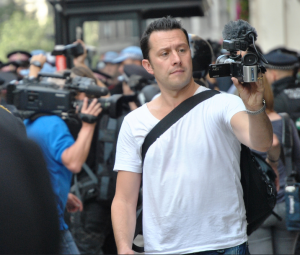 The public increasingly depend on citizen journalists to witness and record events objectively, and to hold the mainstream media to account for honesty and authenticity, according to Stuart Allan, Professor of Journalism and Communication at Cardiff University in the UK.
The public increasingly depend on citizen journalists to witness and record events objectively, and to hold the mainstream media to account for honesty and authenticity, according to Stuart Allan, Professor of Journalism and Communication at Cardiff University in the UK.
In his book, Citizen Witnessing: Revisioning Journalism in Times of Crisis, Allan argues that most citizen journalists are effectively citizen witnesses – people who find themselves at the scene of an event by chance and spontaneously record, photograph and write about it, posting directly to the public via social media. He believes that as technology makes such amateur journalism easier, it will become more a more integral and accepted part of newsgathering. Allan discussed his research with the EJO:
One might say that citizen journalism is simply journalism made by citizens. Is the definition of citizen journalism so easy?
It is often journalists who are referring to their fellow citizens as citizen journalists. We need to think carefully about what happens, when people are labelled as amateur or citizen journalists. We might also explore who is actually using the phrase ‘citizen journalist’ to describe themselves and what they are doing. It is a relatively small number of people who think of themselves in this way. Often these definitional tensions prove significant where bearing witness is concerned, which is why I have been differentiating “citizen witnessing” from citizen journalism in my recent work.
Is citizen journalism a phenomenon of recent years, or did some kind of practice, which can be described as citizen journalism, exist before we started using the term?
The phrase ‘citizen journalism’ enters journalism’s vocabulary in the aftermath of the tsunami in south eastern Asia in December 2004.
However, I would suggest that the notion of citizen journalism is as old as journalism itself. From today’s perspective, we can look back and see early examples of what we might currently call citizen journalism, long before the term itself became part of a journalistic lexicon, such as Abraham Zapruder’s ‘home-movie’ of US President John F. Kennedy’s assassination in Dallas, Texas in 1963. Variously described as “amateur newsies,” “personal journalists,” “do-it-yourself reporters,” and the like, they represent an example of how citizens secured visual evidence that engendered powerful insights with profound implications for public life.
How would you describe a citizen journalist and what is his or her motivation for the task?
I have been using the phrase ‘citizen witness’ to describe people who find themselves on the scene of a crisis event – an accident, disaster, conflict or even in a warzone – who have the presence of mind to try to document what they’re seeing. They may be at the scene purely by chance, or perhaps purposely so, but in any case strive to record what’s happening from their perspective or vantage point. It is this sense of witnessing that is crucial though, in my view, regardless of whether or not the person involved self-identifies as a citizen journalist.
How do news organizations and editors cope with citizen journalists? How do they approach it?
This is precisely the challenge that journalists and editors continue to ponder.
Your question uses the word ‘cope,’ which was the initial attitude – it was all about trying to contain or manage citizen content by keeping it at arm’s length from ‘real’ reporting – but now I think it is more likely to be regarded in positive terms. The smarter news organizations, in my view, try to forge innovative, collaborative relationships with their readers, listeners or viewers. This sense of partnership is part of a larger, dramatic shift that has taken place over recent years, and is still working its way through in practical terms. The first person on the scene documenting what is happening is likely to be an ordinary citizen. Moreover, he or she will be likely sharing their content – their personal reportage – with others, possibly via social networking sites.
How can editors verify that information from citizen journalists is true and what are the dangers of using them?
Journalists and editors are under pressure to be constantly improving their strategies to independently verify the credibility of the material they are gathering from members of the public. Journalists and editors face intense pressure to make swift decisions, sometimes before the facts have been fully determined. Resisting the rush to judgment can be difficult, but the better news organisation will slow down long enough to get the story right.
Do you have any examples when editors failed in their task?
In the immediate aftermath of the South Asian tsunami in 2004 and early 2005, there were a small number of occasions when images in circulation were later shown to have been taken at a different disaster years earlier. I remember the same problem occurred following Haiti’s earthquake in 2010, amongst other examples.
But still, despite these dangers, news organisations are willing to use this kind of content. What extra quality or added value does it have?
From the news organisation’s point of view, it is much cheaper to monitor and process citizen material than to actually employ their own network of journalists to gather news independently. Citizen imagery, in particular, is very popular with audiences. Content that is popular and relatively inexpensive is going to be almost irresistible for a news organization.
When it comes to explaining why some people seem to prefer citizen imagery, we need to conduct further investigation. Recently, I have been doing some research along these lines with Dr Chris Peters in the Netherlands. We conducted qualitative opinion surveys with young people in Canada, the Netherlands and the UK to explore such questions. Many of the participants in our study recognised that professional photojournalists are much more likely to generate better quality images in keeping with objective news reporting, but nonetheless feared that such imagery was less truthful than that provided by ordinary citizens who accidently found themselves on the scene. Citizens were credited with producing imagery that was more honest or authentic.
Has, in your opinion, citizen journalism somehow changed the norms and practices of professional journalism?
Speaking in general terms, journalists often tended to be rather insulated from their readers, viewers or listeners. This is no longer so. Members of the public can subject virtually everything a journalist produces to very close interrogation. They will be forthcoming in sharing their commentary and critique. Journalists, as a result, have to take care with what they say and do, knowing that any slip or mistake is likely to generate emails, tweets or challenges in the blogosphere.
Flickr Creative Commons: Shawn Hayward
Tags: Citizen journalism, citizen witnessing, Digital Technology, Research, Social media












































